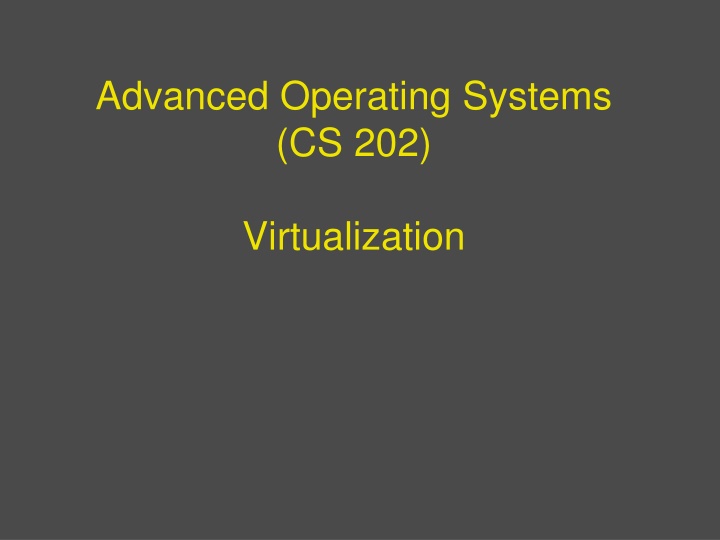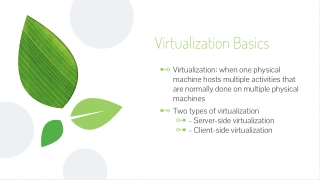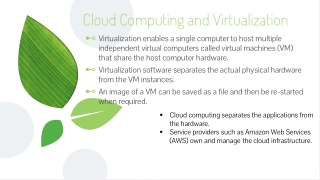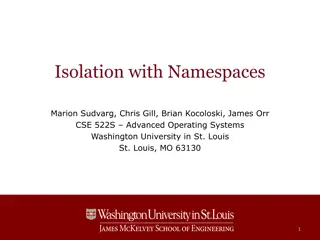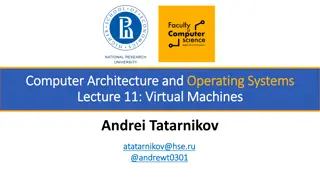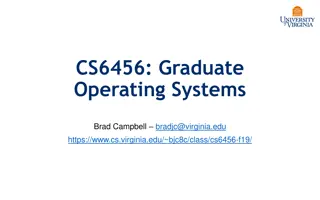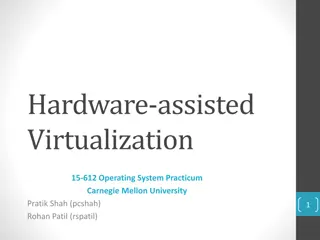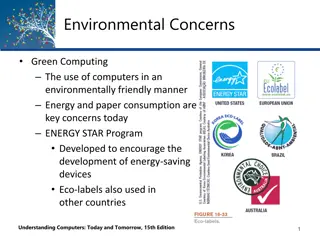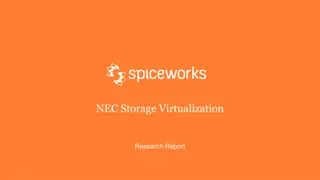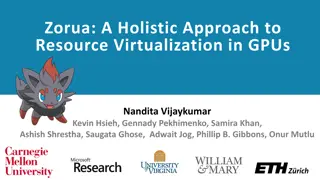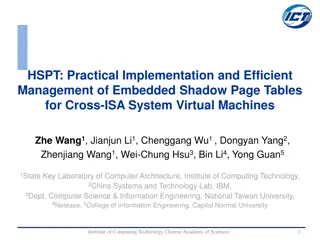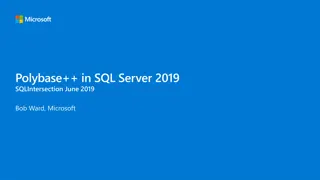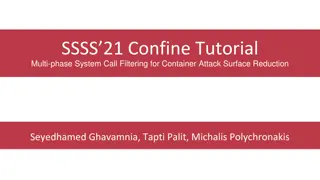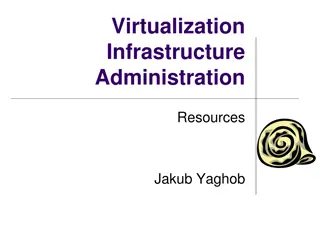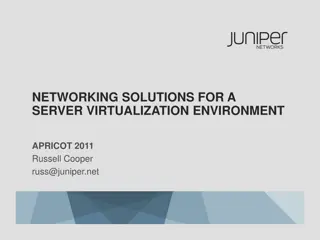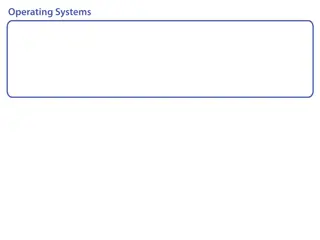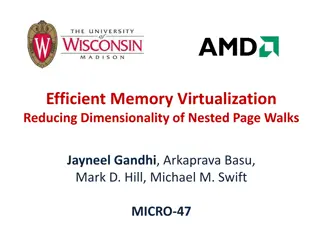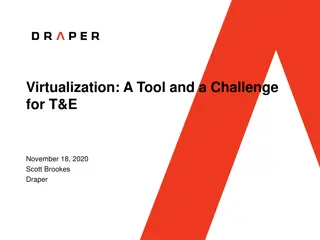Overview of Virtualization Benefits and Models
Virtualization in advanced operating systems, including its definition, benefits, motivation, implementation methods, hypervisor types, hybrid organizations, historical context, and full virtualization concepts. Explore the evolution and impact of virtualization technologies.
Uploaded on Feb 20, 2025 | 6 Views
Download Presentation

Please find below an Image/Link to download the presentation.
The content on the website is provided AS IS for your information and personal use only. It may not be sold, licensed, or shared on other websites without obtaining consent from the author.If you encounter any issues during the download, it is possible that the publisher has removed the file from their server.
You are allowed to download the files provided on this website for personal or commercial use, subject to the condition that they are used lawfully. All files are the property of their respective owners.
The content on the website is provided AS IS for your information and personal use only. It may not be sold, licensed, or shared on other websites without obtaining consent from the author.
E N D
Presentation Transcript
Advanced Operating Systems (CS 202) Virtualization
Virtualization One of the natural consequences of the extensibility research we discussed What is virtualization and what are the benefits? 2
Virtualization motivation Cost: multiplex multiple virtual machines on one hardware machine Cloud computing, data center virtualization Why not processes? Why not containers? Heterogeneity: Allow one machine to support multiple OS s Maintaining compatibility Other: security, migration, energy optimization, customization, 3
How do we virtualize? Create an operating system to multiplex resources among operating systems! Exports a virtual machine to the Operating systems Called a hypervisor or Virtual Machine Monitor (VMM) 4
Two types of hypervisors Type 1: Native (bare metal) Hypervisor runs on top of the bare metal machine e.g., KVM Type 2: Hosted Hypervisor is an emulator e.g., VMWare, virtual box, QEMU 6
Hybrid organizations Some hybrids exist, e.g., Xen Mostly bare metal VM0/Dom0 to keep device drivers out of VMM 7
Stepping back some history IBM VM 370 (1970s) Microkernels (late 80s/90s) Extensibility (90s) SIMOS (late 90s) Eventually became VMWare (2000) Xen, Vmware, others (2000s) Ubiquitous use, Cloud computing, data centers, Makes computing a utility 8
Full virtualization Idea: run guest operating systems unmodified However, supervisor is the real privileged software When OS executes privileged instruction, trap to hypervisor who executes it for the OS This can be very expensive Also, subject to quirks of the architecture Example, x86 fails silently if some privileged instructions execute without privilege E.g., popf 9
Example: Disable Interrupts Guest OS tries to disable interrupts the instruction is trapped by the VMM which makes a note that interrupts are disabled for that virtual machine Interrupts arrive for that machine Buffered at the VMM layer until the guest OS enables interrupts. Other interrupts are directed to VMs that have not disabled them
Binary translation--making full virtualization practical Use binary translation to modify OS to rewrite silent failure instructions More aggressive translation can be used Translate OS mode instructions to equivalent VMM instructions Some operations still expensive Cache for future use Used by VMWare ESXi and Microsoft Virtual Server Performance on x86 typically ~80-95% of native 11
Binary Translation Example Guest OS Assembly do_ atomic_ operation: cli mov eax, 1 xchg eax, [lock_ addr] test eax, eax jnz spinlock mov [lock_ addr], 0 sti ret Translated Assembly do_ atomic_ operation: call [vmm_ disable_ interrupts] mov eax, 1 xchg eax, [lock_ addr] test eax, eax jnz spinlock mov [lock_ addr], 0 call [vmm_ enable_ interrupts] ret 12
Paravirtualization Modify the OS to make it aware of the hypervisor Can avoid the tricky features Aware of the fact it is virtualized Can implement optimizations Comparison to binary translation? Amount of code change? 1.36% of Linux, 0.04% for Windows 13
Hardware supported virtualization (Intel VT-x, AMD-V) Hardware support for virtualization Makes implementing VMMs much simpler Streamlines communication between VM and OS Removes the need for paravirtualization/binary translation EPT: Support for shadow page tables More later 14
What needs to be done? Virtualize hardware Memory hierarchy CPUs Devices Implement data and control transfer between guests and hypervisor We ll cover this by example Xen paper Slides modified from presentation by J ianmin Chen 16
Xen Design principles: Unmodified applications: essential Full-blown multi-task O/Ss: essential Paravirtualization: necessary for performance and isolation
Xen VM interface: Memory Memory management Guest cannot install highest privilege level segment descriptors; top end of linear address space is not accessible Guest has direct (not trapped) read access to hardware page tables; writes are trapped and handled by the VMM Physical memory presented to guest is not necessarily contiguous
Two Layers of Virtual Memory Physical address machine address Host OS s View of RAM Virtual address physical address 0xFFFFFFFF Guest OS s View of RAM Guest App s View of RAM 0xFFFF Page 2 Page 0 Page 0 0xFF Page 3 Page 2 Page 1 Page 3 Page 1 Page 0 Page 3 Page 1 0x00 Page 2 Unknown to the guest OS 0x0000 Known to the guest OS 0x00000000
Guests Page Tables Are Invalid Guest OS page tables map virtual page numbers (VPNs) to physical frame numbers (PFNs) Problem: the guest is virtualized, doesn t actually know the true PFNs The true location is the machine frame number (MFN) MFNs are known to the VMM and the host OS Guest page tables cannot be installed in cr3 Map VPNs to PFNs, but the PFNs are incorrect How can the MMU translate addresses used by the guest (VPNs) to MFNs? 22
Shadow Page Tables Solution: VMM creates shadow page tables that map VPN MFN (as opposed to VPN PFN) Guest Page Table Physical Memory VPN 00 (0) 01 (1) 10 (2) 11 (3) 00 VPN 00 (0) 01 (1) 10 (2) PFN 01 (1) 10 (2) 11 (3) 64 Page 3 Maintained by the guest OS Invalid for the MMU 48 Page 2 32 Virtual Memory Page 1 16 64 Page 0 0 Page 3 48 Page 2 32 Shadow Page Table Machine Memory Page 1 (0) MFN 10 (2) 11 (3) 16 64 Page 0 Page 3 Maintained by the VMM Valid for the MMU 0 48 Page 2 32 Page 1 16 23 Page 0 0 00 (0)
Building Shadow Tables Problem: how can the VMM maintain consistent shadow pages tables? The guest OS may modify its page tables at any time Modifying the tables is a simple memory write, not a privileged instruction Thus, no helpful CPU exceptions :( Solution: mark the hardware pages containing the guest s tables as read-only If the guest updates a table, an exception is generated VMM catches the exception, examines the faulting write, updates the shadow table 24
More VMM Tricks The VMM can play tricks with virtual memory just like an OS can Balooning: The VMM can page parts of a guest, or even an entire guest, to disk A guest can be written to disk and brought back online on a different machine! Deduplication: The VMM can share read-only pages between guests Example: two guests both running Windows XP 25
Xen VM interface: CPU CPU Guest runs at lower privilege than VMM Exception handlers must be registered with VMM Fast system call handler can be serviced without trapping to VMM Hardware interrupts replaced by lightweight event notification system Timer interface: both real and virtual time
Details: CPU Frequent exceptions: Software interrupts for system calls Page faults Allow guest to register a fast exception handler for system calls that can be accessed directly by CPU in ring 1, without switching to ring-0/Xen Handler is validated before installing in hardware exception table: To make sure nothing executed in Ring 0 privilege. Doesn t work for Page Fault
Xen VM interface: I/O I/O Virtual devices exposed as asynchronous I/O rings to guests Event notification replaces interrupts
Details: I/O 1 Xen does not emulate hardware devices Exposes device abstractions for simplicity and performance I/O data transferred to/from guest via Xen using shared-memory buffers Virtualized interrupts: light-weight event delivery mechanism from Xen-guest Update a bitmap in shared memory Optional call-back handlers registered by O/S
Details: I/O 2 I/O Descriptor Ring:
OS Porting Cost Number of lines of code modified or added compared with original x86 code base (excluding device drivers) Linux: 2995 (1.36%) Windows XP: 4620 (0.04%) Re-writing of privileged routines; Removing low-level system initialization code
Control Transfer Guest synchronously call into VMM Explicit control transfer from guest O/S to monitor hypercalls VMM delivers notifications to guest O/S E.g. data from an I/O device ready Asynchronous event mechanism; guest O/S does not see hardware interrupts, only Xen notifications
Event notification Pending events stored in per-domain bitmask E.g. incoming network packet received Updated by Xen before invoking guest OS handler Xen-readable flag may be set by a domain To defer handling, based on time or number of pending requests Analogous to interrupt disabling
Data Transfer: Descriptor Ring Descriptors are allocated by a domain (guest) and accessible from Xen Descriptors do not contain I/O data; instead, point to data buffers also allocated by domain (guest) Facilitate zero-copy transfers of I/O data into a domain
Network Virtualization Each domain has 1+ network interfaces (VIFs) Each VIF has 2 I/O rings (send, receive) Each direction also has rules of the form (<pattern>,<action>) that are inserted by domain 0 (management) Xen models a virtual firewall+router (VFR) to which all domain VIFs connect
Network Virtualization Packet transmission: Guest adds request to I/O ring Xen copies packet header, applies matching filter rules E.g. change header IP source address for NAT No change to payload; pages with payload must be pinned to physical memory until DMA to physical NIC for transmission is complete Round-robin packet scheduler
Network Virtualization Packet reception: Xen applies pattern-matching rules to determine destination VIF Guest O/S required to exchange unused page frame for each packet received Xen exchanges packet buffer for page frame in VIF s receive ring If no receive frame is available, the packet is dropped Avoids Xen-guest copies; requires pagealigned receive buffers to be queued at VIF s receive ring
Disk virtualization Domain0 has access to physical disks Currently: SCSI and IDE All other domains: virtual block device (VBD) Created & configured by management software at domain0 Accessed via I/O ring mechanism Possible reordering by Xen based on knowledge about disk layout
Disk virtualization Xen maintains translation tables for each VBD Used to map requests for VBD (ID,offset) to corresponding physical device and sector address Zero-copy data transfers take place using DMA between memory pages pinned by requesting domain Scheduling: batches of requests in round-robin fashion across domains
Microbenchmarks Stat, open, close, fork, exec, etc Xen shows overheads of up to 2x with respect to native Linux (context switch across 16 processes; mmap latency) VMware shows up to 20x overheads (context switch; mmap latencies) UML shows up to 200x overheads Fork, exec, mmap; better than VMware in context switches
VT-x : Motivation To solve the problem that the x86 instructions architecture cannot be virtualized. Simplify VMM software by closing virtualization holes by design. Ring Compression Non-trapping instructions Excessive trapping Eliminate need for software virtualization (i.e paravirtualization, binary translation). 42
VMX Virtual Machine Extensions define processor-level support for virtual machines on the x86 platform by a new form of operation called VMX operation. Kinds of VMX operation: root: VMM runs in VMX root operation non-root: Guest runs in VMX non-root operation Eliminate de-privileging of Ring for guest OS. 44
Pre VT-x Post VT-x VMM ring de-privileging of guest OS Guest OS aware its not at Ring 0 VMM executes in VMX root-mode Guest OS de-privileging eliminated Guest OS runs directly on hardware 45
VMX Transitions Transitions between VMX root operation and VMX non-root operation. Kinds of VMX transitions: VM Entry: Transitions into VMX non-root operation. VM Exit: Transitions from VMX non-root operation to VMX root operation. Registers and address space swapped in one atomic operation. 46
VM 1 VM 2 VM n VMX Non-Root Operation Ring 3 Ring 3 Ring 3 Ring 0 Ring 0 Ring 0 VM Entry VMC S 1 VMC S 2 VMC S n VM Exit Ring 3 VMX Root Operation vmlaunch / vmresume Ring 0 VMX Transitions 47
VMCS: VM Control Structure Data structure to manage VMX non-root operation and VMX transitions. Specifies guest OS state. Configured by VMM. Controls when VM exits occur. 48
VMCS: VM Control Structure The VMCS consists of six logical groups: Guest-state area: Processor state saved into the guest- state area on VM exits and loaded on VM entries. Host-state area: Processor state loaded from the host- state area on VM exits. VM-execution control fields: Fields controlling processor operation in VMX non-root operation. VM-exit control fields: Fields that control VM exits. VM-entry control fields: Fields that control VM entries. VM-exit information fields: Read-only fields to receive information on VM exits describing the cause and the nature of the VM exit. 49
CPU Virtualization with VT-x 50 Source: [2]
